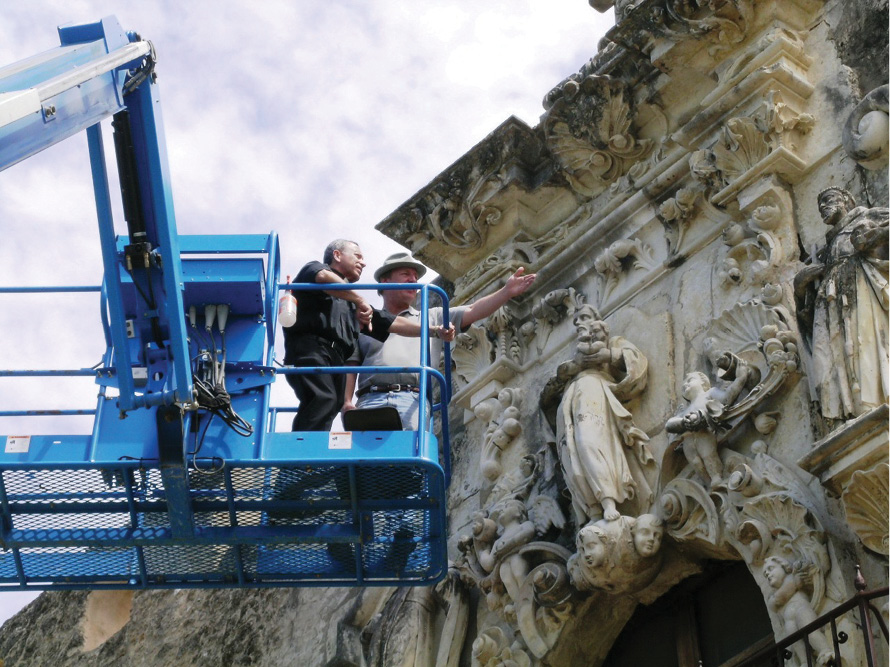BY CAROL BAASS SOWA
TODAY’S CATHOLIC
Final in a seven-part series.
 SAN ANTONIO • Father David Garcia, appointed in 2007 to assist ailing Father Balthasar “Balty” Janacek, longtime director of the Old Spanish Missions Inc., officially took the reins following Father Janacek’s passing in spring 2007 and has been working tirelessly on the missions’ behalf ever since. When appointed, he was still serving as rector of San Fernando Cathedral through 2008 and had just completed its extensive fundraising campaign and restoration, with the renovation of adjacent Main Plaza nearing completion.
SAN ANTONIO • Father David Garcia, appointed in 2007 to assist ailing Father Balthasar “Balty” Janacek, longtime director of the Old Spanish Missions Inc., officially took the reins following Father Janacek’s passing in spring 2007 and has been working tirelessly on the missions’ behalf ever since. When appointed, he was still serving as rector of San Fernando Cathedral through 2008 and had just completed its extensive fundraising campaign and restoration, with the renovation of adjacent Main Plaza nearing completion.
“That was the last thing on my bucket list as rector of the cathedral,” he recalls, “even though the plaza doesn’t belong to the diocese.” He worked very closely on the plaza project with Mayor Phillip Hardberger, who had appointed him to the Main Plaza Conservancy. It involved building a relationship between the church and the city, something that would serve Father Garcia well in his new role with the missions.
Father Janacek had reached the $2 million mark of a $15.5 million capital campaign at the time of his death, which Fr. Garcia and his Las Misiones advisory committee immediately took on, reaching their goal in just two years. “That was in the depths of the Great Recession,” notes Father Garcia, “so it was really quite a project to be able to pull off.” From this, $4.5 million was set aside for a long-needed endowment fund which has since grown to $7 million. “It really should be two or three times that amount of money,” says Father Garcia, “because restoration of these kinds of buildings is very expensive.”
He immediately began working with the archdiocese’s architects, Ford, Powell & Carson, to systematically establish where the money was needed most for each of the missions. All four received major interior restoration between 2009 and 2015. Additionally, there was the restoration of Mission San José’s ornate façade and Rose Window, stabilization of Mission San Juan with a 39-feet-deep pier and beam foundation; and restoration of the convento at Mission San Francisco de la Espada.
When all was completed, a grant from the Texas Historical Commission funded an architectural and engineering study assessing and prioritizing mission needs through 2025 which will require $8.5 million. Each mission also received a maintenance manual with basics for their pastors to keep track of, as certain things are parish responsibilities.
 “My office exists to maintain these missions,” says Father Garcia, “and to be sure they are in good shape and they don’t fall down again.” He also must address needs of the parishes, as they continue to be “living missions and not just museums,” so more money will need to be raised. “It never ends,” he says, “and so, as we go forward, we’ll raise more money.”
“My office exists to maintain these missions,” says Father Garcia, “and to be sure they are in good shape and they don’t fall down again.” He also must address needs of the parishes, as they continue to be “living missions and not just museums,” so more money will need to be raised. “It never ends,” he says, “and so, as we go forward, we’ll raise more money.”
The strong relationship the archdiocese and National Park Service have had since 1978 will continue, he relates, as they partner on a day to day aspects of the missions, as well as major projects such as the World Heritage Festival in September, and keep each other apprised of scheduled activities.
Father Garcia also serves as pastor at Mission Concepción and notes its attendance has more than doubled in the six years he has been there, attributable to World Heritage designation of the missions in 2015 and increasing Southside growth. “We’ve more than tripled our income in terms of donations,” he says. Concepción’s small church seats 400 and the two Sunday Masses are always full, with the noon mariachi Mass tending to be at least half visitors, both from out-of-town and other parts of the city.
He attributes the increase in international visitors to the World Heritage designation. “We’re seeing a lot more Europeans and a lot more Asians,” he relates, “Filipinos, Chinese, Japanese, Koreans.” There is also a steady stream from Mexico and Latin America. When the apartments and Pilgrimage Center open at the adjacent former St. John’s Seminary, he foresees a need for more Masses at Concepción.
Being a World Heritage Site has been good for the missions, he says, but has brought some tension to the South side with the need for regulations so mission views are not obstructed and to determine what can be built nearby. New apartments near Mission Concepción were approved by that neighborhood, happy to see the empty seminary no longer attracting vagrants and vandals. Mission San Jose’s neighborhood, on the other hand, has been against proposals for construction near that mission. This dynamic interchange between the missions and their environment will continue, he believes, impacted further as mission visitors increase.
Another future challenge will be gentrification. “There’s a certain amount of desire to preserve the character and the nature of those neighborhoods,” he says, “but at the same time, there is this unrelenting pressure that people want to live close to this wonderful river and these parks.” However, present residents should be able to continue to live there and not be priced out of their neighborhood, he says, noting this must be addressed carefully. “Changing neighborhood,” he says thoughtfully, “is going to be a challenge in the future.”


